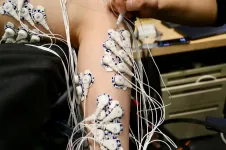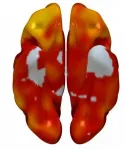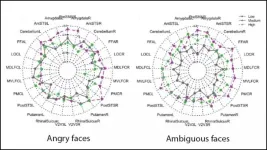Counterintuitive approach may improve eyewitness identification
2021-02-15
(Press-News.org) Experts have devised a novel approach to selecting photos for police lineups that helps witnesses identify culprits more reliably.
In a paper published by the Proceedings of the National Academy of Sciences, researchers - from the University of California San Diego and Duke University in the United States and the University of Birmingham in the U.K. - show for the first time that selecting fillers who match a basic description of the suspect but whose faces are less similar, rather than more, leads to better outcomes than traditional approaches in the field.
The counterintuitive technique improves eyewitness performance by about 10 percent.
"In practice, police tend to err on the side of picking facially similar fillers for their lineups," said John Wixted, the paper's senior author and a professor in the UC San Diego Department of Psychology. "What our study shows is that it is, contrary to intuition, actually better to pick fillers who are facially dissimilar. Doing it this way continues to protect the innocent to the same degree while helping witnesses to correctly identify the guilty more frequently."
In a study of 19,732 participants, the researchers played a mock-crime video depicting a white male stealing an office laptop and then provided photographs of one suspect (either the perpetrator or an innocent suspect) plus five police lineup fillers. The fillers always matched the most basic description of the perpetrator but they varied in how much they facially resembled him. Facial similarity among photos was scored by an additional set of participants on a scale of 1 to 7, with 7 being most similar.
The researchers found that picking fillers who were facially dissimilar enhanced the ability of eyewitnesses to accurately pick out the perpetrator when he was in the lineup, without increasing the likelihood of wrongly identifying an innocent suspect when the real perpetrator was not in the lineup.
In a typical police lineup, one photo of the suspect is displayed, plus photos of five or more "fillers" who are known to be innocent. To create a fair lineup in which the suspect does not stand out, fillers are selected if they are similar in basic appearance to the suspect (height, weight, race, hair color and length, etc.), or if they have facial features included in a witness's description of the culprit. Often, a combined approach is used, in which fillers with similar facial features are selected from a pool of description-matched photos.
For decades, experts have disagreed on and puzzled over the question of what is most effective, while also being fair to the suspect. There are concerns that using fillers that are too facially similar to the suspect will confuse eyewitnesses and protect guilty suspects by making the identification task too difficult. Conversely, if the fillers are too facially dissimilar to the suspect, there are concerns that this would put an innocent suspect at risk of being falsely identified.
The new approach relied on insights from signal detection theory - which considers the memory strengths that are generated by each face in the lineup in the mind of the eyewitness - to deduce that selecting fillers who are not facially similar to the suspect from a pool of acceptable description-matched photos actually increases the ability of eyewitnesses to discriminate between innocent and guilty suspects.
Importantly, this approach did not have any effect on the number of "false alarms," in which an innocent suspect is incorrectly identified.
INFORMATION:
Study co-author Melissa Colloff, of the University of Birmingham's School of Psychology, said: "Eyewitness misidentifications have contributed to many wrongful convictions, which are later overturned by DNA evidence. Eyewitnesses failing to identify a perpetrator when he is in the lineup can also result in guilty perpetrators being free to commit additional crimes. Although many useful reforms have been introduced to protect the innocent, sometimes these will also protect the guilty. Our approach demonstrates it is possible to create police lineups that are more effective for everyone involved - increasing the likelihood that a guilty perpetrator will be identified, without increasing the likelihood that an innocent suspect will be imperilled."
The study's other co-authors are Brent M. Wilson of UC San Diego and Travis M. Seale-Carlisle of Duke University. The study was supported by the College of Life and Environmental Sciences, University of Birmingham (Colloff) and the Laura and John Arnold Foundation (Wixted).
ELSE PRESS RELEASES FROM THIS DATE:
2021-02-15
CAMBRIDGE, MA -- MIT researchers have invented a new type of amputation surgery that can help amputees to better control their residual muscles and sense where their "phantom limb" is in space. This restored sense of proprioception should translate to better control of prosthetic limbs, as well as a reduction of limb pain, the researchers say.
In most amputations, muscle pairs that control the affected joints, such as elbows or ankles, are severed. However, the MIT team has found that reconnecting these muscle pairs, allowing them to retain their normal push-pull ...
2021-02-15
The threat of landslides is again in the news as torrential winter storms in California threaten to undermine fire-scarred hillsides and bring deadly debris flows crashing into homes and inundating roads.
But it doesn't take wildfires to reveal the landslide danger, University of California, Berkeley, researchers say. Aerial surveys using airborne laser mapping -- LiDAR (light detection and ranging) -- can provide very detailed information on the topography and vegetation that allow scientists to identify which landslide-prone areas could give way during an expected rainstorm. This is especially ...
2021-02-15
More than one-third of the Corn Belt in the Midwest - nearly 100 million acres - has completely lost its carbon-rich topsoil, according to University of Massachusetts Amherst research that indicates the U.S. Department of Agricultural has significantly underestimated the true magnitude of farmland erosion.
In a paper published in the Proceedings of the National Academy of Sciences, researchers led by UMass Amherst graduate student Evan Thaler, along with professors Isaac Larsen and Qian Yu in the department of geosciences, developed a method using satellite ...
2021-02-15
The links between cardiovascular disease and cognitive impairment begin years before the appearance of the first clinical symptoms of either condition. In a study carried out at the Centro Nacional de Investigaciones Cardiovasculares (CNIC) in partnership with Santander Bank and neuroimaging experts at the Barcelonaβeta Brain Research Center (BBRC, the research center of the Fundación Pasqual Maragall), the investigators have identified a link between brain metabolism, cardiovascular risk, and atherosclerosis during middle age, years before the first appearance of symptoms.
The report, published in the Journal of the American College of Cardiology (JACC), ...
2021-02-15
Employing cardiovascular disease prevention strategies in mid-life may delay or stop the brain alterations that can lead to dementia later in life, according to a study in the Journal of the American College of Cardiology.
Atherosclerosis, or buildup of fats, cholesterol and other substances in and on artery walls, is the underlying cause of most cardiovascular diseases, which is the leading cause of death around the world. Dementia is also among the top causes of death and disability around the world, with 50 million people currently living with dementia. ...
2021-02-15
In a new study out of University of California San Diego School of Medicine, researchers found a drug used for heart failure improves symptoms associated with postural orthostatic tachycardia syndrome, otherwise known as POTS. This complex, debilitating disorder affects the body's autonomic nervous system, causing a high heart rate, usually when standing.
Writing in the February 15, 2021 online issue of the Journal of the American College of Cardiology, study authors investigated the drug ivabradine and its effects on heart rate, quality of life and plasma norepinephrine levels in persons living with POTS. Norepinephrine is a stress hormone and neurotransmitter. In blood plasma, it is used as a measure of sympathetic nervous system activity. Trial participants experienced a reduction in ...
2021-02-15
Young men with lower testosterone levels throughout puberty become more sensitive to how the hormone influences the brain's responses to faces in adulthood, according to new research published in JNeurosci.
During prenatal brain development, sex hormones like testosterone organize the brain in permanent ways. But research suggests that testosterone levels during another developmental period -- puberty -- may have long-lasting effects on brain function, too.
Liao et al. examined the relationship between puberty testosterone levels and the brain's response to faces. Liao's team recruited 500 men around age 19 who had been participants in the Avon Longitudinal Study of Parents and ...
2021-02-15
PITTSBURGH, Feb. 15, 2021 - By capitalizing on a convergence of chemical, biological and artificial intelligence advances, University of Pittsburgh School of Medicine scientists have developed an unusually fast and efficient method for discovering tiny antibody fragments with big potential for development into therapeutics against deadly diseases.
The technique, published today in the journal Cell Systems, is the same process the Pitt team used to extract tiny SARS-CoV-2 antibody fragments from llamas, which could become an inhalable COVID-19 treatment for humans. This approach has the potential to quickly identify multiple potent nanobodies that target different parts of a pathogen--thwarting ...
2021-02-15
What The Study Did: Data from four studies of children and adolescents exposed to major U.S. hurricanes were pooled to examine posttraumatic stress symptoms after those events and the factors associated with them.
Authors: Betty S. Lai, Ph.D., of Boston College in Chestnut Hill, Massachusetts, is the corresponding author.
To access the embargoed study: Visit our For The Media website at this link https://media.jamanetwork.com/
(doi:10.1001/jamanetworkopen.2020.36682)
Editor's Note: The article includes conflict of interest and funding/support disclosures. Please see the article ...
2021-02-15
Scientists say they have discovered a potential new target for immunotherapy of malignant brain tumors, which so far have resisted the ground-breaking cancer treatment based on harnessing the body's immune system. The discovery, reported in the journal END ...
LAST 30 PRESS RELEASES:
[Press-News.org] Counterintuitive approach may improve eyewitness identification




